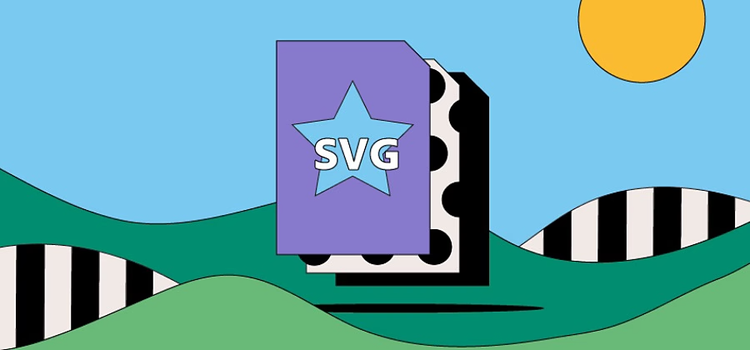Image file conversion just got faster.
Adobe Express makes it easy to get the file type you need SVG, JPG, PNG or even Transparent Files in just a few clicks.
The SVG file format is a popular tool for displaying two-dimensional graphics, charts, and illustrations on websites. Plus, as a vector file, it can be scaled up or down without losing any of its resolution. Learn more about the key features of SVG images, their pros and cons, and how the SVG format has evolved.

Scalable Vector Graphics (SVG) is a web-friendly vector file format. As opposed to pixel-based raster files like JPEGs, vector files store images via mathematical formulas based on points and lines on a grid. This means that vector files like SVG can be significantly resized without losing any of their quality, which makes them ideal for logos and complex online graphics.
It’s not just their resizing abilities that make SVGs hugely popular with web designers. SVGs are written in XML code, meaning they store any text information as literal text rather than shapes. This allows search engines like Google to read SVG graphics for their keywords, which can potentially help a website move up in search rankings.
You can easily spot an SVG file by its .svg extension.
In 1994, Dutch software engineer Martijn Koster first proposed the SVG file format.
The history of the SVG file goes back to the late 1990s when the World Wide Web Consortium (W3C) invited proposals from developers for a new type of vector graphic format. Six competing proposals were submitted and helped inform what eventually became the W3C’s SVG format.
SVGs took some time to grow in popularity. There was relatively little support for them until 2017, when people began to see the benefits of using SVGs in modern web browsers. SVG files are now widely used for 2D website images because most browsers and drawing apps for vector files can easily handle them.
It’s worth researching SVG advantages and disadvantages before saving your images in this file format.
From Chrome and Edge to Safari and Firefox, all the major browsers allow you to open SVG files these days — whether you’re on a Mac or Windows. Just launch your browser and click on File
Open to choose the file you want to view. It’ll then be displayed in your browser.
Opening an SVG image with a built-in program on your computer is just as easy. Double-click the file name and you’ll get a list of programs that will open it — or it’ll automatically open in a compatible program.
Follow these steps when using Adobe Photoshop:
A helpful note: since Photoshop is a raster graphics editor, many people prefer to create and edit SVG files in Adobe Illustrator, a vector graphics editor.
Follow these steps when using Adobe Illustrator:
Scalable Vector Graphics (SVG) is a web-friendly vector file format. As opposed to pixel-based raster files like JPEGs, vector files store images via mathematical formulas based on points and lines on a grid. This means that vector files like SVG can be significantly resized without losing any of their quality, which makes them ideal for logos and complex online graphics.
It’s not just their resizing abilities that make SVGs hugely popular with web designers. SVGs are written in XML code, meaning they store any text information as literal text rather than shapes. This allows search engines like Google to read SVG graphics for their keywords, which can potentially help a website move up in search rankings.
You can easily spot an SVG file by its .svg extension.
Scalable Vector Graphics have come a long way in recent years — but what are SVGs used for in practice?
Designers often use SVGs to display website icons like buttons, as well as company logos. This file type’s ability to scale up or down without ever compromising its quality means they’re ideal for graphics that need to appear in multiple places and in a range of sizes.
Thanks to the use of XML within SVG files, search engines like Google can read text-heavy charts and graphs, which can help with search engine optimization. Because Google can detect keywords within SVGs, it can potentially push a webpage to a higher rank in search results. Plus, to help make web pages just that much more interesting, SVGs also support animation.
Adobe Express makes it easy to get the file type you need SVG, JPG, PNG or even Transparent Files in just a few clicks.
US$22.99/mo
Get Photoshop on desktop and iPad as part of Creative Cloud.
US$69.99/mo
Get 20+ Creative Cloud apps, including Photoshop on desktop and iPad.
See what's included | Learn more
US$24.99/mo
Save over 60% on Creative Cloud Pro.
See terms | Learn more